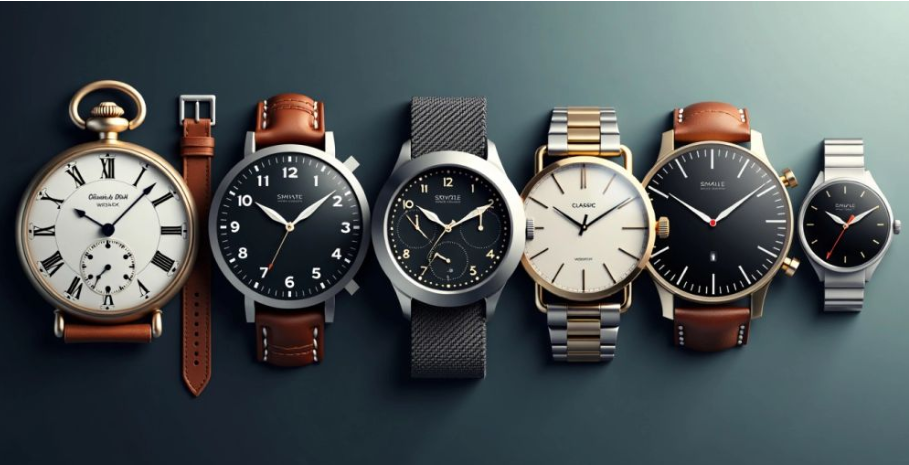The Evolution of Watch Design: From Classic to Contemporary Trends

Watches have come a long way from their early days as pocket watches to the sophisticated smartwatches of today. This journey reflects not only changes in technology but also shifts in fashion and culture. By looking at the evolution of watch design, we can see how these timepieces have adapted to meet the needs and tastes of different eras.
The Early Days of Watchmaking
Pocket Watches and Their Significance
In the 16th century, the first portable timepieces emerged, often worn as pendants or attached to clothing. These early watches, crafted by skilled artisans, were intricate mechanisms encased in precious metals and adorned with elaborate engravings. They were a luxury only the wealthy could afford, symbolizing status and were often given as gifts to royalty and nobility.
Transition to Wristwatches
The early 20th century marked a pivotal moment in watch design with the advent of the wristwatch. Initially considered a novelty for women, wristwatches gained popularity among men during World War I due to their practicality on the battlefield. Soldiers found it more convenient to glance at their wrists rather than fumbling for a pocket watch, leading to a surge in demand for wristwatches. Today, this historical shift has even influenced the rise of replicas, with the Replica Rolex being a popular choice for those who admire classic designs but may not have access to the original pieces. While they capture the style, they lack the historical significance and craftsmanship of authentic models.
Influence of World War I on Watch Design
World War I significantly influenced watch design, making wristwatches a staple of men’s fashion post-war. Brands like Rolex and Omega led the charge, evolving designs to be more rugged and functional, suitable for everyday wear. The Art Deco movement of the 1920s and 1930s further influenced watch design, introducing geometric shapes, bold colors, and new materials like stainless steel.
The Impact of Art Movements on Watch Design
Art Deco and Geometric Shapes
The Art Deco movement of the 1920s and 1930s brought a fresh wave of creativity to watch design. Watches became smaller and more streamlined, featuring geometric shapes and bold, symmetrical patterns. Rectangular and square cases gained popularity, and dial designs became more minimalist and sophisticated.
Mid-Century Modernism
The mid-20th century was a golden age for watch design, characterized by elegance and innovation. During the 1940s and 1950s, watches became slimmer and more streamlined, reflecting the minimalist aesthetics of the era. The introduction of automatic (self-winding) movements revolutionized convenience, eliminating the need for daily winding.
The Role of Minimalism
Minimalism played a significant role in the evolution of watch design, especially during the mid-20th century. This design philosophy emphasized simplicity, functionality, and the use of clean lines. Watches from this era often featured uncluttered dials, slim cases, and understated elegance.
The influence of these art movements can still be seen in contemporary watch designs, where the balance between form and function remains a key consideration.
Technological Advancements and Their Influence
The Quartz Revolution
The 1970s marked a pivotal moment in watchmaking with the introduction of the quartz movement. This innovation made watches more affordable and accurate. Quartz watches, powered by batteries, were cheaper to produce and maintained time more accurately than mechanical watches. This era, known as the Quartz Crisis, challenged traditional Swiss watchmakers but also spurred innovation and diversification in design.
Introduction of Digital Watches
The advent of digital watches brought new features like calculators, alarms, and even games. Brands like Casio and Timex led the way with LED and LCD displays. These watches prioritized functionality and convenience, reflecting a shift towards more contemporary designs.
Rise of Smartwatches
In the 21st century, smartwatches revolutionized the watch industry. These devices, pioneered by tech giants like Apple and Samsung, offer features such as fitness tracking, health monitoring, and connectivity with other smart devices. Smartwatches have blurred the lines between technology and fashion, becoming extensions of our smartphones and, by extension, of ourselves.
The blend of traditional craftsmanship and modern technology in watch design reflects a broader trend towards combining classic elegance with contemporary innovation.
Luxury Watches as Status Symbols
Rolex and the Birth of Iconic Models
Rolex is a name synonymous with luxury and precision. The brand’s journey began with the introduction of the Rolex Oyster in 1926, the world’s first waterproof wristwatch. This innovation set the stage for future iconic models like the Rolex Datejust, launched in 1945. These watches became symbols of elegance and innovation. However, the market is also flooded with replica Rolex watches, making it essential for buyers to distinguish between genuine and fake Rolex timepieces.
Patek Philippe and Haute Horology
Patek Philippe is another giant in the world of luxury watches. Known for its commitment to craftsmanship, the brand introduced the Calatrava in 1932, a model that epitomizes understated elegance. Patek Philippe’s dedication to haute horology has made it a favorite among collectors and connoisseurs. The brand’s timepieces are often seen as investments, with their value appreciating over time.
The Emergence of Luxury Sports Watches
In recent years, luxury sports watches have gained immense popularity. Brands like Audemars Piguet and Hublot have led this trend with models that combine robustness with sophistication. These watches are designed to withstand extreme conditions while maintaining a luxurious appearance. The rise of luxury sports watches has also led to an increase in the production of high-quality replicas, making it crucial for buyers to be cautious when purchasing these timepieces.
Luxury watches are more than just timekeeping devices; they are symbols of status, craftsmanship, and style. Whether it’s a classic Rolex or a contemporary luxury sports watch, owning a luxury timepiece is a statement of one’s taste and sophistication.
Contemporary Trends in Watch Design
Sustainability in Watchmaking
Today, many watchmakers are focusing on sustainability. They are using recycled materials and adopting eco-friendly practices. This shift shows a broader trend towards responsible luxury. Consumers now want products that match their values, and watch brands are listening.
Customization and Limited Editions
People love unique and special items. Watch brands are offering more personalized options and limited editions. This makes the watches more appealing and helps create a stronger bond between the brand and the customer.
Fusion of Traditional and Modern Elements
Modern watch designs often mix classic styles with new technologies. This blend keeps the timeless elegance of traditional watches while adding modern features. The result is a watch that looks great and offers the latest in functionality.
The Future of Watch Design
Integration of Smart Technology
The future of watch design will see a deeper integration of smart technology. Hybrid watches that combine traditional mechanical movements with smart features are becoming more popular. These watches offer the best of both worlds: the craftsmanship of classic watches and the functionality of modern technology. Expect features like activity tracking, notifications, and even solar charging to become standard.
Use of Advanced Materials
Advances in materials science will play a significant role in the future of watch design. New materials like carbon fiber, ceramics, and even advanced alloys will make watches more durable and lightweight. These materials will also allow for more innovative designs and functionalities, such as increased water resistance and scratch-proof surfaces.
Read more: Understanding the Role of a Probate Administration Lawyer in Estate Planning
Personalized and Custom Designs
Personalization will be a key trend in the future. Consumers are increasingly looking for unique, custom-designed watches that reflect their individual style. Watchmakers are responding by offering more options for customization, from interchangeable straps to bespoke engravings. Limited edition releases will also become more common, allowing brands to create exclusive, one-of-a-kind pieces.
The future of watch design is a blend of tradition and innovation, ensuring that timepieces remain not just tools for telling time but expressions of individuality and style.
Conclusion
In conclusion, the journey of watch design from classic to contemporary trends showcases the blend of tradition and innovation. From the elegant pocket watches of the early 1900s to the tech-savvy smartwatches of today, each era has left its mark on the world of horology. As technology advances and consumer preferences evolve, watchmakers continue to push the boundaries of design and functionality. Yet, the timeless appeal of classic craftsmanship remains ever-present. Whether you prefer the simplicity of a vintage timepiece or the modern features of a smartwatch, the evolution of watch design offers something for everyone. The future of watchmaking promises even more exciting developments, ensuring that watches will remain a cherished accessory for generations to come.
Frequently Asked Questions
What were the early types of watches?
The earliest types of watches were pocket watches, which were popular in the 18th and 19th centuries. They were often luxurious and carried in a person’s pocket, attached to a chain.
How did wristwatches become popular?
Wristwatches gained popularity during World War I because they were more practical for soldiers to use. After the war, they became a common accessory for men.
What impact did the Art Deco movement have on watch design?
The Art Deco movement introduced geometric shapes and bold, symmetrical patterns to watch design. This era also saw the rise of rectangular and square cases.
What was the Quartz Revolution?
The Quartz Revolution began in the 1970s with the introduction of quartz technology, which made watches more accurate and affordable. This period also saw the rise of digital watches.
Why are luxury watches considered status symbols?
Luxury watches are seen as status symbols due to their craftsmanship, precision, and association with prestigious brands like Rolex and Patek Philippe.
What are some contemporary trends in watch design?
Modern watch design trends include sustainability, customization, and the fusion of traditional and modern elements. Smartwatches and hybrid watches are also very popular today.






